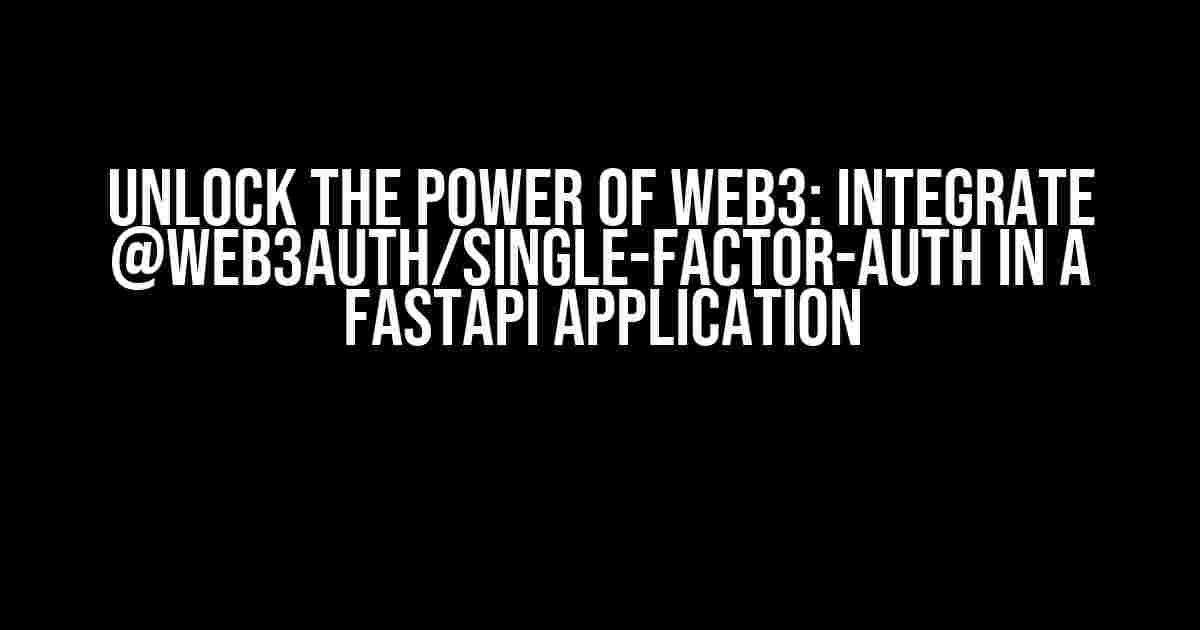Imagine a world where users can seamlessly authenticate with your FastAPI application using their favorite Web3 wallet, without the need for tedious usernames and passwords. Welcome to the future of authentication, made possible by @web3auth/single-factor-auth! In this article, we’ll take you by the hand and guide you through the process of integrating this revolutionary library into your FastAPI project.
What is @web3auth/single-factor-auth?
@web3auth/single-factor-auth is a JavaScript library that enables users to authenticate with your application using a single factor, such as their Web3 wallet, social media account, or even a QR code. This library simplifies the authentication process, making it more secure, convenient, and user-friendly. By integrating @web3auth/single-factor-auth into your FastAPI application, you can:
- Reduce friction and improve user experience
- Enhance security by eliminating password-related vulnerabilities
- Expand your user base by supporting a wide range of Web3 wallets and platforms
Prerequisites
Before we dive into the integration process, make sure you have the following prerequisites in place:
FastAPIinstalled and set up in your project (obviously!)Python 3.7+installed on your machine- A basic understanding of FastAPI and Python development
- A Web3 wallet, such as MetaMask or Ledger Live, for testing purposes
Step 1: Install @web3auth/single-factor-auth
To integrate @web3auth/single-factor-auth into your FastAPI application, you’ll need to install the library using npm:
npm install @web3auth/single-factor-authStep 2: Create a Web3Auth Instance
Create a new file, e.g., web3auth.py, and import the Web3Auth class:
from web3auth.single_factor_auth import Web3Auth
web3auth = Web3Auth(
client_id="YOUR_CLIENT_ID",
client_secret="YOUR_CLIENT_SECRET",
redirect_uri="YOUR_REDIRECT_URI",
chain_id="YOUR_CHAIN_ID",
scope=["openid", "email", "profile"]
)Replace the placeholders with your actual Web3Auth credentials and configuration settings.
Step 3: Configure FastAPI to Use Web3Auth
Update your FastAPI application to use the Web3Auth instance created in Step 2:
from fastapi import FastAPI, Depends
from fastapi.security import OAuth2PasswordBearer
from web3auth import web3auth
app = FastAPI()
oauth2_scheme = OAuth2PasswordBearer(tokenUrl="token")
@app.get("/login")
async def login_user(token: str = Depends(oauth2_scheme)):
user = web3auth.authenticate(token)
return {"message": f"Logged in as {user.name}"}In this example, we’ve created a FastAPI endpoint that accepts an Authorization header with a Bearer token. The oauth2_scheme function is used to validate the token, and the web3auth.authenticate method is called to authenticate the user.
Step 4: Integrate Web3Auth with Your Frontend
index.html, and add the following HTML and JavaScript code:<!DOCTYPE html>
<html>
<head>
<title>Web3Auth Example</title>
</head>
<body>
<h1>Web3Auth Example</h1>
<button id="login-btn">Login with Web3Auth</button>
<script>
const loginBtn = document.getElementById("login-btn");
loginBtn.addEventListener("click", async () => {
const authResponse = await web3auth.authenticate();
const token = authResponse.access_token;
// Send the token to your FastAPI backend for authentication
const response = await fetch("/login", {
method: "GET",
headers: {
Authorization: `Bearer ${token}`
}
});
const userData = await response.json();
console.log(userData);
});
</script>
</body>
</html>This code sets up a basic HTML page with a login button. When the button is clicked, the JavaScript code uses the web3auth.authenticate method to authenticate the user and retrieve an access token. The token is then sent to your FastAPI backend for authentication, which returns the user data.
Testing and Debugging
To test your integration, follow these steps:
- Start your FastAPI application with
uvicorn app:app --host 0.0.0.0 --port 8000 - Open your Web3 wallet and ensure you’re connected to the correct network (e.g., Ethereum Mainnet)
- Open a web browser and navigate to
http://localhost:8000 - Click the “Login with Web3Auth” button
- If prompted, grant access to your Web3 wallet
- Verify that you’re redirected to your FastAPI application with the user data
If you encounter any issues during testing, use the Web3Auth debug tool to troubleshoot the problem:
web3auth.debug(true)This will enable verbose logging and help you identify the root cause of the issue.
Conclusion
Congratulations! You’ve successfully integrated @web3auth/single-factor-auth into your FastAPI application. By following these steps, you’ve unlocked the power of Web3 authentication and provided a seamless experience for your users. Remember to explore the full capabilities of Web3Auth and FastAPI to build innovative applications that bridge the gap between traditional web2 and the decentralized web3 world.
Additional Resources
If you’re hungry for more information or want to dive deeper into the world of Web3 authentication, check out these resources:
| Resource | Description |
|---|---|
| Web3Auth Documentation | Official Web3Auth documentation, covering setup, usage, and troubleshooting |
| FastAPI Documentation | Official FastAPI documentation, covering setup, usage, and best practices |
| Web3Auth GitHub Repository | Web3Auth open-source repository, featuring examples, issues, and community contributions |
Happy coding, and remember to keep exploring the vast possibilities of Web3!
Here are 5 questions and answers about integrating @web3auth/single-factor-auth in a FastAPI application:
Frequently Asked Questions
Get answers to the most commonly asked questions about integrating @web3auth/single-factor-auth in a FastAPI application.
What is @web3auth/single-factor-auth and how does it relate to FastAPI?
@web3auth/single-factor-auth is a library that enables single-factor authentication for web3 applications. It can be integrated into a FastAPI application to provide a secure and seamless authentication experience for users.
Why would I want to use @web3auth/single-factor-auth in my FastAPI application?
Using @web3auth/single-factor-auth in your FastAPI application provides a simple and secure way to authenticate users without requiring them to create a username and password. This reduces friction and makes it easier for users to access your application.
How do I integrate @web3auth/single-factor-auth into my FastAPI application?
To integrate @web3auth/single-factor-auth into your FastAPI application, you’ll need to install the library using npm or yarn, then import and initialize it in your application code. You’ll also need to configure the authentication flow to suit your application’s requirements.
Can I customize the authentication flow using @web3auth/single-factor-auth?
Yes, @web3auth/single-factor-auth provides a range of customization options to adapt the authentication flow to your application’s specific needs. You can customize the authentication UI, add custom authentication providers, and more.
Is @web3auth/single-factor-auth compatible with other FastAPI authentication libraries?
Yes, @web3auth/single-factor-auth is designed to be compatible with other FastAPI authentication libraries, allowing you to use it in conjunction with other authentication mechanisms to provide a more comprehensive authentication solution.
